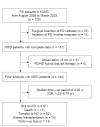Immediate-start peritoneal dialysis without break-in-period: an 18-year retrospective cohort study on patient survival
- PMID: 38389148
- PMCID: PMC11985293
- DOI: 10.23876/j.krcp.23.103
Immediate-start peritoneal dialysis without break-in-period: an 18-year retrospective cohort study on patient survival
Abstract
Background: Immediate-start peritoneal dialysis (ISPD) is an effective renal replacement therapy that can prevent central venous catheterization due to its immediate initiation of peritoneal dialysis (PD) after catheter insertion without a break-in period. This study aimed to investigate the effect of ISPD on long-term patient survival.
Methods: In this retrospective single-center cohort study, 178 consecutive patients who started PD from August 2005 to March 2023 were enrolled, from whom 144 patients with ISPD were analyzed. PD was initiated without a break-in period within 24 hours of catheter insertion using percutaneous needle-guidewire technique. The primary outcome was patient survival, estimated using the Kaplan-Meier method. A Cox proportional hazard regression model was used to identify factors independently associated with patient survival.
Results: The median follow-up period was 4.00 years (interquartile range, 1.23-5.75 years). The mean age of patients was 61.6 ± 13.6 years; 58 patients (40.3%) were male and 93 patients (64.6%) were diabetic. Overall patient survival rates at 1, 3, 5, and 10 years were 98.5%, 93.5%, 92.1%, and 65.6%, respectively. The technique survival rates at 1, 3, 5, and 10 years were 88.1%, 74.9%, 63.2%, and 40.2%, respectively. The peritonitis-free survival rates at 1, 3, 5, and 10 years were 92.3%, 76.0%, 59.4%, and 28.0%, respectively. In the multivariate analysis, diabetes was the only factor associated with patient survival and technique survival.
Conclusion: Our study demonstrated that patient survival and technique survival rates were relatively high in ISPD patients who were catheterized using percutaneous needle-guidewire technique.
Keywords: Peritoneal dialysis; Renal replacement therapy; Risk factors; Survival; Treatment outcome.
Conflict of interest statement
All authors have no conflicts of interest to declare.
Figures



Similar articles
-
Comparison of survival outcomes in haemodialysis versus immediate-start peritoneal dialysis: A propensity-matched study.Nephrology (Carlton). 2025 Jan;30(1):e14418. doi: 10.1111/nep.14418. Nephrology (Carlton). 2025. PMID: 39675379
-
Comparing long-term outcomes between early and delayed initiation of peritoneal dialysis following catheter implantation.Ren Fail. 2016 Jul;38(6):875-81. doi: 10.3109/0886022X.2016.1165069. Epub 2016 Apr 7. Ren Fail. 2016. PMID: 27056580
-
Early and Late Patient Outcomes in Urgent-Start Peritoneal Dialysis.Perit Dial Int. 2017 Jul-Aug;37(4):414-419. doi: 10.3747/pdi.2016.00158. Epub 2016 Dec 22. Perit Dial Int. 2017. PMID: 28007763
-
Urgent-start peritoneal dialysis versus haemodialysis for people with chronic kidney disease.Cochrane Database Syst Rev. 2021 Jan 27;1(1):CD012899. doi: 10.1002/14651858.CD012899.pub2. Cochrane Database Syst Rev. 2021. PMID: 33501650 Free PMC article.
-
Urgent-start peritoneal dialysis versus conventional-start peritoneal dialysis for people with chronic kidney disease.Cochrane Database Syst Rev. 2020 Dec 15;12(12):CD012913. doi: 10.1002/14651858.CD012913.pub2. Cochrane Database Syst Rev. 2020. PMID: 33320346 Free PMC article.
References
-
- United States Renal Data System . National Institute of Diabetes and Digestive and Kidney Diseases, National Institutes of Health; c2020. 2020 Annual report: end stage renal disease: chapter 1. Incidence, prevalence, patient characteristics, and treatment modalities [Internet] [cited 2023 Apr 28]. Available from: https://usrds-adr.niddk.nih.gov/2022/end-stage-renal-disease/1-incidence....
-
- Ghaffari A. Urgent-start peritoneal dialysis: a quality improvement report. Am J Kidney Dis. 2012;59:400–408. - PubMed
-
- Patel PR, Kallen AJ, Arduino MJ. Epidemiology, surveillance, and prevention of bloodstream infections in hemodialysis patients. Am J Kidney Dis. 2010;56:566–577. - PubMed
Grants and funding
LinkOut - more resources
Full Text Sources
Medical

